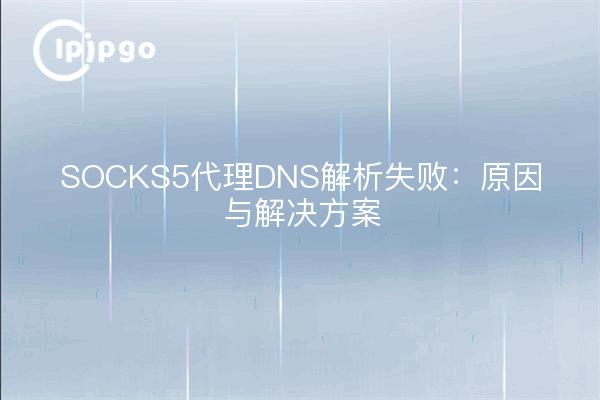
When using SOCKS5 proxy, sometimes we will encounter the problem of DNS resolution failure. This situation will lead to the inability to access the target website, affecting our normal online experience. In this article, we will introduce the reasons for DNS resolution failure of SOCKS5 proxy in detail and provide corresponding solutions to help you solve this problem easily.
What is a SOCKS5 Agent?
SOCKS5 proxy is a network protocol used to transfer network packets through a proxy server. Unlike HTTP proxies, SOCKS5 proxies work at a much lower level and can handle various types of traffic, including HTTP, HTTPS, FTP, and so on. Simply put, SOCKS5 proxy is like a universal middleman that helps you pass all kinds of data.
Common Causes of DNS Resolution Failures
There can be many reasons why DNS resolution fails when using the SOCKS5 proxy. The following are some of the common reasons:
1. Proxy server not configured for DNS resolution
Some proxy servers are not configured for DNS resolution, resulting in clients not being able to resolve DNS through the proxy server. It's like when you go to a restaurant and the waiter doesn't know what's on the menu.
2. Client not properly configured for DNS resolution
The client's configuration may also cause DNS resolution to fail. For example, the client may be set to resolve DNS locally instead of through a proxy server. It's like you're traveling abroad and you're still using a map of your home country to find your way around.
3. Interference by firewalls or security software
Some firewalls or security software may block DNS requests, causing DNS resolution to fail. It's like trying to call to order food and having your call blocked.
prescription
For the above reasons, we can take the following solutions to solve the problem of SOCKS5 proxy DNS resolution failure:
1. Configuring DNS resolution for proxy servers
Make sure the proxy server is configured for DNS resolution. If you are the administrator of the proxy server, you can check and configure the DNS server addresses. Here are some common ways to configure it:
# On Linux systems, you can edit the /etc/resolv.conf file to add the DNS server addresses
nameserver 8.8.8.8
nameserver 8.8.4.4
If you are using a third-party proxy service, it is recommended to contact the service provider to confirm whether it supports DNS resolution.
2. Configure client DNS resolution
Ensure that the client is configured for DNS resolution through a proxy server. As an example, the commonly used SSH tool can add the `-o` option when connecting:
ssh -D 1080 -o "ProxyCommand=nc -x 127.0.0.1:1080 %h %p" user@remote_host
In this way, all DNS requests are resolved through the SOCKS5 proxy.
3. Checking firewalls and security software
Check the settings of your firewall and security software to make sure they are not blocking DNS requests. You can temporarily disable the firewall or security software and test if that solves the problem. If the firewall or security software does cause the problem, you can add the appropriate rules to allow DNS requests to pass.
Practical case studies
To better understand the solution, let's look at a real-world example.
Xiaoming is using a SOCKS5 proxy to access a foreign website and finds that he cannot resolve the domain name. He checked the configuration of the proxy server and found that DNS resolution was enabled. So, Xiao Ming suspected that it was a client problem.
He opened the client's configuration file and found that DNS resolution was set to local resolution. He changed it to resolve through a proxy server, reconnected, and the problem was solved.
Xiaoming's experience tells us that when encountering DNS resolution failure problems, you may want to start with the configuration of the proxy server and the client and troubleshoot one by one.
concluding remarks
Although SOCKS5 Proxy DNS Resolution Failure is a common problem, it can be easily solved by identifying the cause and adopting appropriate solutions. I hope this article can help you better understand and cope with this problem, so that your online experience will be smoother.
If you encounter difficulties in actual operation, you may refer to the solutions provided in this article or seek help from professionals. I wish you to solve the problem of DNS resolution failure soon and enjoy the excitement of the network world!








